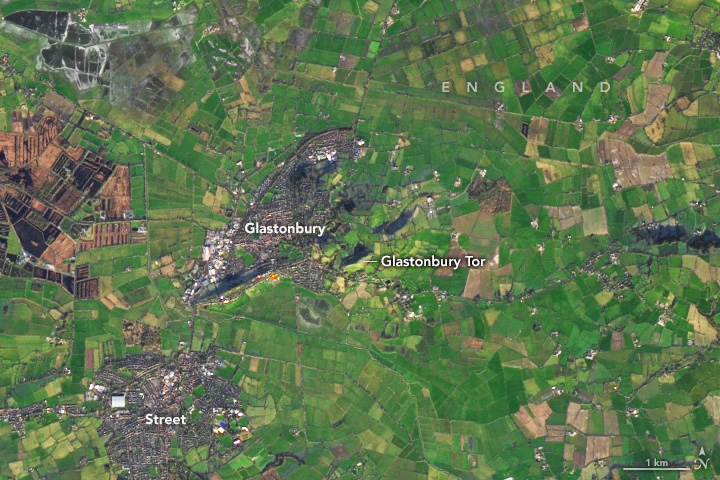
The History and Mystery of Glastonbury
Downloads
- glastonbury_oli_20240119_lrg.jpg (1122x748, JPEG)
Metadata
- Sensor(s):
- Landsat 8 - OLI
- Data Date: January 19, 2024
- Visualization Date: July 31, 2024
The town of Glastonbury in southern England is well known for its annual music festival, which started in 1970. But tales about the site and its conspicuous hill, or tor, date back to the Middle Ages. The town is tied to accounts relating to paganism, Christianity, and King Arthur, the legendary ruler of England after Roman occupation.
Glastonbury is situated on a plateau in the Somerset Levels, a 60,000-hectare expanse of flat wetlands and farmland. In the otherwise low-lying region, a 158-meter (518-foot) hill dominates the skyline. The steep, isolated hill, also known as Glastonbury Tor, allows for a unique vantage point of its surroundings. The shadow of the tor can be seen just east of Glastonbury in this image, acquired on January 19, 2024, by the OLI (Operational Land Imager) on Landsat 8.
Before the Somerset Levels were drained and converted into agricultural land in the 18th century, the region was a flooded swamp. Glastonbury Tor towered above the water as an island, drawing attention as a site of worship for pagans and Christians. Several medieval buildings once stood on the tor’s summit, forming the monastery of St. Michael. Now all that remains is a ruined church tower from the 14th century.
Archeological excavations of Glastonbury indicate that the area was settled by the Romans and Saxons, but artifacts found on the plateau date as far back as the Mesolithic period (10,000 to 5,000 years ago). Glastonbury Abbey, near the foot of the tor, is believed to be the site of the earliest Christian church in Britain and became a prominent center of worship during the medieval period.
The abbey is also the alleged resting place of the apocryphal King Arthur. Some sources portray Arthur as a leader of post-Roman England in battles against the Saxons in the late 5th and early 6th centuries. In the legend, Arthur was revealed as the true king when he pulled a sword from a stone, and he established the knights of the round table during his reign. However, it’s unclear whether the stories of Arthur are based on a historical person.
During King Henry VIII’s reformation of churches in the 16th century, he ordered the dissolution of monasteries, including Glastonbury Abbey. King Arthur’s reputed tomb was also destroyed, but a plaque commemorating the burial place remains among the abbey’s ruins.
References & Resources
- BBC (2024, June 24) The revival of Britain’s myth-shrouded, sacred wetlands. Accessed August 1, 2024.
- Gilchrist, R. and Green, C. (2015) Glastonbury Abbey: archaeological investigations 1904–79. The Society of Antiquaries of London, The Antiquaries Journal, 96, 446–449.
- Historic England (2000, October 6) St Michael’s Church, monastic remains, and other settlement remains on Glastonbury Tor. Accessed August 1, 2024.
- National Trust Glastonbury Tor. Accessed August 1, 2024.
- Smithsonian (2022, September) Was King Arthur a Real Person? Accessed August 1, 2024.
- UK Environment Agency (2023, December 5) Somerset Levels and Moors: reducing the risk of flooding. Accessed August 1, 2024.
NASA Earth Observatory image by Wanmei Liang, using Landsat data from the U.S. Geological Survey. Story by Emily Cassidy.
This image record originally appeared on the Earth Observatory. Click here to view the full, original record.